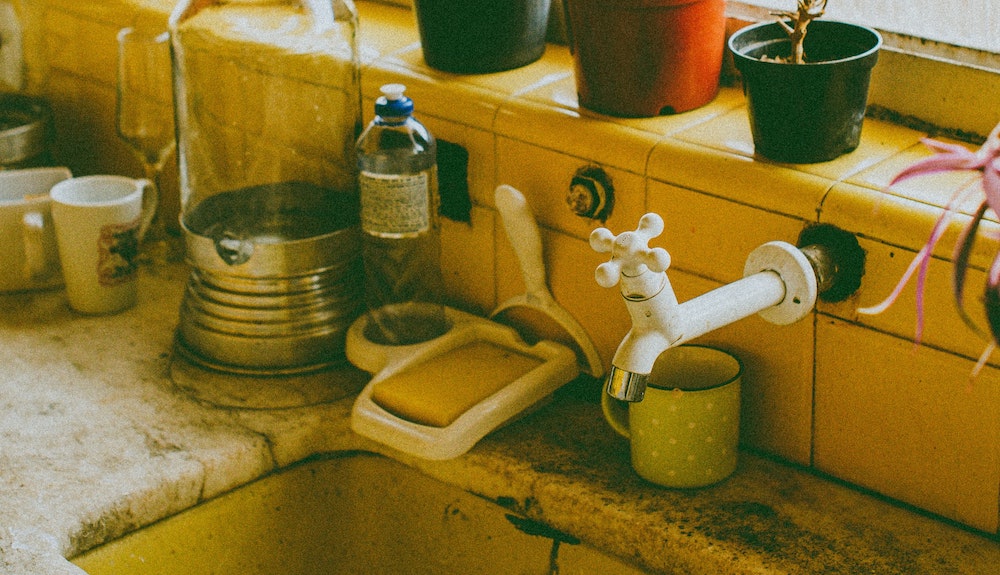How To Remove A Kitchen

Whether you're planning a grand renovation, dealing with an outdated design, or simply feel like a complete revamp is in order, knowing how to properly dismantle your kitchen is the first significant step.
It can save you a bundle in professional costs and even give you a sense of satisfaction, seeing the old make way for the new.
So, brace yourself for some DIY and let's embark on this journey of transforming your kitchen space!
Click Here to See Our Range of DIY Kitchens Online...
How To Remove A Kitchen Step-by-Step
Here’s a step-by-step guide on how to remove your kitchen.
Remember before doing anything, safety is always first, so ensure you have necessary safety equipment like gloves, goggles, and potentially a hard hat depending on the extent of your kitchen removal.
- Turn Off Utilities: First, ensure that all the utilities, such as gas, electricity, and water, are turned off. You can usually do this at the mains. This step is crucial for safety.
- Empty the Cabinets: Remove all items from your kitchen cabinets and drawers. This not only makes the units lighter to carry but also prevents anything from getting damaged or causing harm.
- Remove Appliances: Next, begin removing your appliances. This includes your oven, refrigerator, dishwasher, and any other appliances that are part of the kitchen. Some of these may be integrated with your cabinets, so ensure they're fully disconnected before removal.
- Remove the Sink: Disconnect the plumbing from the sink. There should be shut-off valves for both the hot and cold water supply pipes. After they're off, you can disconnect the pipes. Once the plumbing is disconnected, you can lift the sink out of the counter-top.
- Take Out the Counter-tops: With the sink out of the way, you can start to remove the counter-tops. These are often screwed into the cabinets from below. Once you've unscrewed them, you should be able to lift the counter-tops off.
- Dismantle the Cabinets: With the counter-tops removed, you can start to take out the cabinets. These are usually screwed into the wall. You'll need to unscrew them and then they should pull away from the wall. Start with the upper cabinets first, then move to the lower ones.
- Remove the Kitchen Island: If you have a kitchen island, the removal process is similar to the cabinets. Disconnect any power or plumbing, then unscrew it from the floor. Depending on the size and weight, you may need some help for this step.
- Take Off the Tiles: If you're also planning to remove the tiles, start from the top and work your way down, using a chisel or a similar tool to pry them off the wall. Be careful of sharp edges and flying debris.
- Check for Hidden Connections: After everything is removed, check for any hidden connections or waste pipes. You may find that some were connected to the appliances or hidden behind cabinets.
- Clean Up: Finally, clean up your space. There will likely be a lot of dust and debris, so make sure to sweep and vacuum thoroughly.
Remember, while removing a kitchen yourself can be a cost-effective method, it's essential to consider your skill level and the time commitment required.
If any step seems too challenging or dangerous, it's always best to hire a professional.
Click here to see our complete range of kitchen 1810 sinks...
Is it Safe to DIY Remove a Kitchen?
Taking on the task of removing a kitchen by yourself can be a feasible and satisfying DIY project, with a number of tasks that are generally safe to undertake, given you're prepared, equipped, and cautious.
That said, it's essential to approach this task understanding its limitations and risks.
Clearing out cabinets, removing non-integrated appliances, and even dismantling most cabinets and worktops can typically be done with a good set of tools, some protective wear, and a dose of patience.
However, when it comes to elements such as electrical or gas appliances, it's a completely different kettle of fish.
In the UK, it's not just a good idea to leave gas and electrical work to the professionals – it's actually the law.
Any work that involves gas must be carried out by a Gas Safe registered engineer.
Similarly, major electrical work should be undertaken by a qualified electrician.
This isn't just because of the immediate risk of injury (or worse) when dealing with these volatile utilities, but also because improper installations can lead to serious hazards down the line, including fires, gas leaks, or electric shocks.
So yes, while you can roll up your sleeves and safely tackle a good portion of kitchen removal, there are certain elements where professional assistance isn't just recommended, but required.
Don't risk your safety or the integrity of your home; when it comes to gas or electrical work, it's always better to get a pro involved.
How Hard is it to Remove a Kitchen?
The difficulty of removing a kitchen really depends on a variety of factors.
If you're a seasoned DIYer with a tool kit that's bursting at the seams and experience in similar projects, you might find the process quite straightforward.
However, if you're new to this sort of task, it could present more of a challenge.
Here are a few considerations that might influence the difficulty level:
- The Size and Complexity of Your Kitchen: A small kitchen with a straightforward layout is going to be easier to remove than a large, complex one with lots of units and appliances.
- Your DIY Skills and Experience: If you're comfortable with tools and have taken on similar projects before, you'll likely find it easier than someone who's new to DIY.
- The Level of Professional Help You Need: As mentioned before, gas and electrical work must be done by a professional. If your kitchen is heavily wired, or has multiple gas appliances, you may need to involve a professional more than you'd initially thought, which could add complexity to the task.
- The Amount of Help You Have: Removing a kitchen is not a one-person job. You'll need at least one other person to help with heavy lifting and carrying. If you're going it alone, it will certainly be harder.
In essence, removing a kitchen is not an easy job and it's not a quick job. It requires a fair bit of elbow grease, a lot of patience, and careful planning.
However, the sense of accomplishment once the job is done can make the process well worth it.
Just remember - safety first, always.
Can You Remove and Reuse a Kitchen?
Yes, indeed! If you're careful during the removal process, you can certainly remove and reuse a kitchen.
This can be a brilliant way to save money or to help the environment by reducing waste.
However, there are a few key things to bear in mind:
- Be Gentle: The key to successfully reusing kitchen units is careful removal. You'll want to avoid damaging the cabinets as you take them out. Use the right tools, and take your time.
- Plan Ahead: Measure your new space and plan out where everything will go. It might not all fit in exactly the same configuration, especially if your new kitchen is a different size or shape.
- Check the Condition: Older kitchens may have worn out parts that need replacing. Check the condition of things like drawer runners and hinges. It's also worth remembering that if the kitchen units have been in place for a long time, there may be some colour difference on exposed and unexposed parts.
- Consider the Plumbing and Electrics: You'll need to consider how plumbing and electrical items will fit in your new kitchen. The sink and appliances might not be in the same place, and you'll need to plan accordingly.
- Hire a Professional if Necessary: If you're not confident doing this yourself, consider hiring a professional.
They have the skills and experience to remove kitchens without damaging them, and can also advise on how best to fit your reused kitchen into its new home.
Reusing a kitchen is a great project, and with some careful planning and a bit of work, you can give a second life to a set of kitchen units.
Tips From an Expert Kitchen Fitter
Before considering removing a kitchen yourself or with a budding DIY enthusiast, it’s important to remember that removing a kitchen can be as complex as fitting a kitchen, especially if you’re looking to salvage any of the kitchen units to reuse or sell on.
However if you’ve been looking for a reason to smash your ugly and outdated kitchen to smithereens, always consult the other half before doing so and make sure you’re geared up with goggles and a face mask…
But if you’re not wanting to carefully remove your existing kitchen then here are some tips to help you out.
- Plan Ahead: You’ve no doubt heard the phrase; Prepare to plan or plan to fail. So the last thing you want to happen is to experience an epic fail while removing your existing kitchen. So it’s important to have a clear plan on how you want to dismantle your kitchen, ensuring you have all the necessary tools at hand. This will prevent any rushed decisions that could lead to damage or accidents.
- Turn Off Utilities: This is a big one. So many people are seriously hurt or killed each year because they don’t consider the dangers of electricity and gas. So before starting the kitchen removal process, ensure that the gas, water, and electricity supplies are turned off. This reduces the risk of accidental shocks or leaks. For gas and electrical disconnections, a certified professional should be consulted.
- A Poor Tradesman Blames His Tools: Always use the correct tools for the job. For example, a pry bar can be handy for removing counter-tops without causing unnecessary damage. Wear safety gear such as gloves, eye protection, and sturdy footwear to protect yourself from any unforeseen accidents.
- Softly Softly Catchy Monkey: Pay particular attention when removing heavy items. These should always be moved with the help of another person or using appropriate lifting equipment. The last thing you want is to seriously hurt yourself.
- Environmentally Focused: When dismantling your kitchen, consider where each part is going to go and how you’d like to do your part for the environment. So one top tip is to create designated areas for different materials.
Some items like appliances and units in good condition that could be sold or donated, while others can be recycled or disposed of responsibly.
Keep the workspace clean and tidy to prevent trips and falls.
Final Notes On How To Remove A Kitchen
Dismantling a kitchen can be a significant project that requires careful planning, the right tools, and an awareness of safety precautions.
It's essential to disconnect utilities properly, preferably with the assistance of certified professionals for gas and electrical elements.
Employing the right methods and tools is crucial to avoid damage and to ensure personal safety during the process.
Additionally, the heavy components should be handled carefully, with the correct lifting techniques to avoid injury.
Lastly, being environmentally responsible and keeping your workspace tidy will help keep you safe and ensure you're doing your part for the environment.
Always remember, while most of the work can be a DIY project, some aspects are best left to the professionals to ensure safety and compliance with local regulations.


